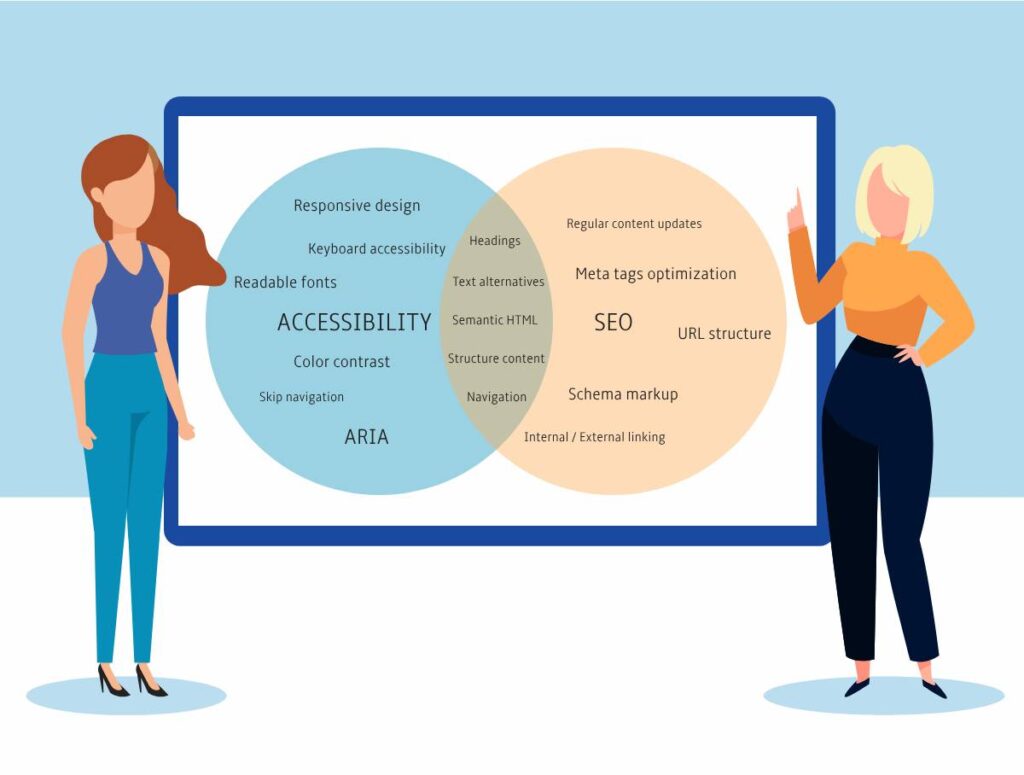Where accessibility meets SEO

Hello, amazing readers! Today, we’re exploring how Accessibility and SEO practices seamlessly overlap, working together like two puzzle pieces to achieve a common goal. Imagine two superheroes joining forces, each with their own superpowers, yet both aiming for the same goal. Let’s uncover the fascinating harmony between headings, text alternatives, semantic HTML, structured content, and navigation.
Headings
Imagine headings as the signposts on your website, guiding visitors through a captivating story. For accessibility, they help screen readers understand the content hierarchy, making the browsing experience smoother for users with visual impairments. Well, guess what? Search engines adore well-structured content too! Utilizing appropriate heading tags not only enhances accessibility but also helps search engines grasp the essential topics on your page, giving your SEO efforts a little boost.
Text Alternatives
Ah, text alternatives, the magical words that make content comprehensible for everyone. While they’re often associated with images, they go beyond that! Think graphs, charts, and videos – all can benefit from descriptive text alternatives. By providing these alternatives, you ensure that everyone, including those using assistive technologies, can access and understand the information. And here’s the icing on the cake: search engines use these descriptions to grasp your content, enhancing your website’s overall visibility and SEO ranking. It’s like making your digital content a universal language that both users and search engines can understand and appreciate. A win-win for sure!
Semantic HTML
What on Earth is “semantic HTML”? Fear not, it’s just a fancy term for using proper HTML elements to convey meaning. Accessibility-wise, semantic HTML ensures that assistive technologies can interpret your content correctly. And, drumroll, please… search engines love it too! Clean, semantic code enables search engines to understand your website’s context better, leading to improved rankings in search results. It’s like building a solid foundation for your virtual castle!
Structured Content
Remember the feeling of reading a well-organized book? The same applies to websites. Structured content makes your digital playground easy to explore, regardless of a user’s abilities. Accessibility enthusiasts rejoice at this user-first approach! But guess what? Search engines are thrilled too! Clear organization and logical flow not only enhance user experience but also make it easier for search engine crawlers to navigate and index your pages, boosting your SEO points.
Navigation
Navigating a website should be as effortless as sailing on calm waters. That’s where accessible navigation comes in, ensuring that all users can sail smoothly through your content. It’s a gift that keeps on giving, as user-friendly navigation also keeps visitors on your site for longer, signaling search engines that your website is valuable. And you know what that means – a shiny boost in your SEO rankings!
Conclusion
Now, here’s the cherry on top: ensuring your digital property is accessible to your customers improves its SEO, and vice versa. When you make your website accessible, you open the doors to a wider audience, including those with disabilities. This expanded reach not only increases your potential customer base but also sends a positive signal to search engines that your website is valuable and relevant to a diverse set of users. On the flip side, implementing SEO best practices, such as optimizing keywords and enhancing user experience, indirectly benefits accessibility by making your content more discoverable and engaging.
So there you have it, the marvelous overlap between Accessibility and SEO practices! By implementing these friendly practices, you create a harmonious environment that not only delights users but also captivates search engines. Remember, in the vast ocean of the internet, making your website accessible and SEO-friendly is like having a compass and a treasure map combined!


